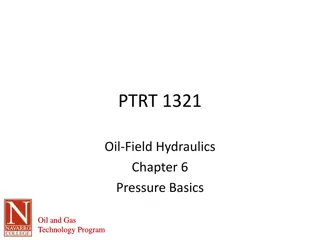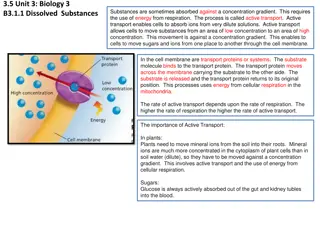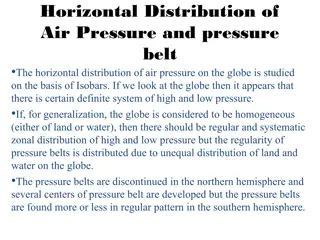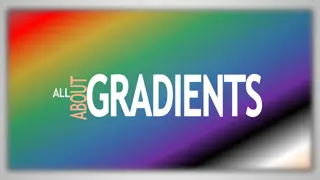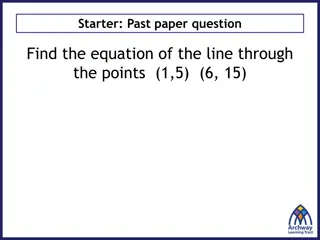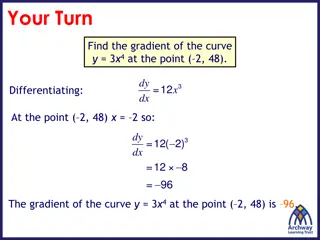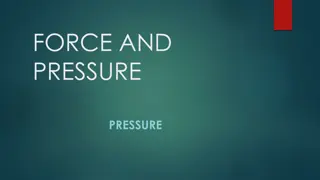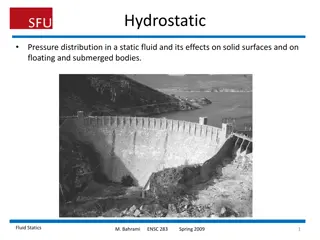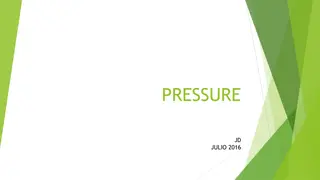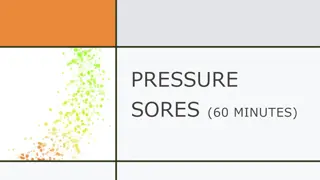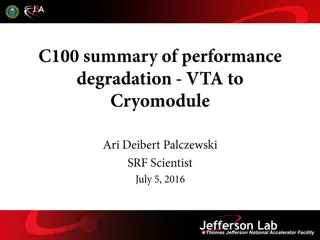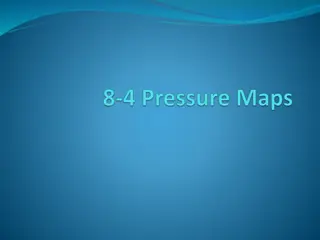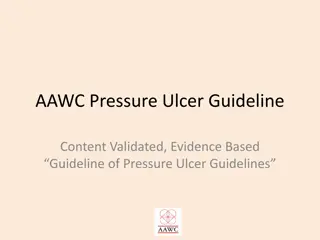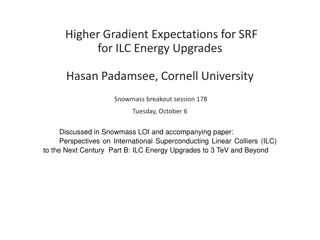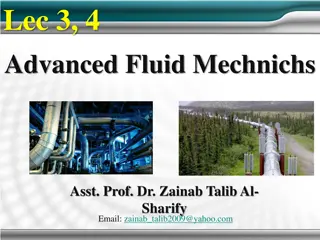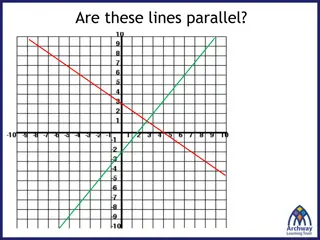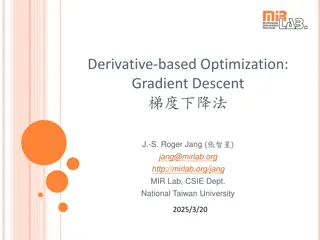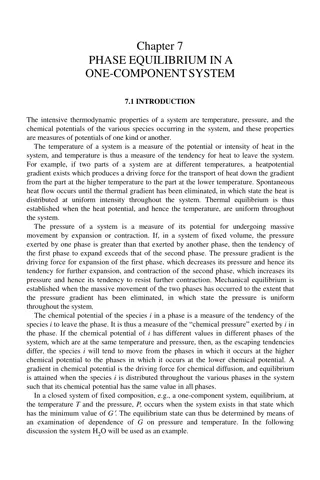Fluid Pressure in Oil Field Hydraulics
Explore the fundamentals of fluid pressure including pressure basics, unit conversion, fluid weight constants, true vertical depth, and hydrostatic pressure in the context of oil and gas technology programs. Learn how to calculate pressure gradients, understand the impact of fluid density on pressur
2 views • 40 slides
Do Input Gradients Highlight Discriminative Features?
Instance-specific explanations of model predictions through input gradients are explored in this study. The key contributions include a novel evaluation framework, DiffROAR, to assess the impact of input gradient magnitudes on predictions. The study challenges Assumption (A) and delves into feature
0 views • 32 slides
Active Transport and Osmosis in Biology
Substances can be absorbed against concentration gradients through active transport, requiring energy from respiration. Cells use transport proteins to move substances across membranes. Osmosis involves the movement of water across a selectively permeable membrane along concentration gradients. The
4 views • 12 slides
Influence of Environmental Factors on Sound Pressure Levels
In this study, the relationship between sound pressure, particle velocity, and the acoustic impedance is explored in the context of varying humidity, temperature, and barometric pressure. The ideal gas law is used to determine the density of both dry and humid air, considering parameters such as par
2 views • 14 slides
Measurement Methods for Pressure Evaluation
The content describes the measurement of pressure using various methods such as Bourdon pressure gauge, diaphragm pressure gauge, and McLeod gauge. It explains the principle of McLeod vacuum gauge, the operation of the gauge, and the components involved. The McLeod gauge works by compressing a known
3 views • 27 slides
Horizontal Distribution of Air Pressure and Pressure Belts on the Globe
The horizontal distribution of air pressure and pressure belts on Earth is characterized by isobars, indicative of high and low pressure systems. The regular zonal distribution of pressure belts is affected by the uneven distribution of land and water. Pressure belts are not solely induced by temper
2 views • 7 slides
Pressure Measurement and Hydrostatic Forces on Surfaces
Measurement of pressure using various gauges like Bourdon and Diaphragm Gauge, different types of pressure gauges like Bellows and Dead Weight Pressure Gauge are discussed. Piezometer and different types of manometers for pressure measurement are also explained. Additionally, the concept of hydrosta
2 views • 11 slides
A Comprehensive Guide to Gradients
Gradients are versatile tools in design, allowing shapes to transition smoothly between colors. Learn about gradient types, preset options, creating your own metallic gradients, and applying gradients effectively in this detailed guide. Explore linear and radial gradient directions, understand gradi
0 views • 7 slides
Rates of Change and Calculus Concepts
Exploring the concept of rates of change through examples like finding the equation of a line passing through given points and understanding differentiation to calculate gradients and speeds. The relationship between gradients, curves, and tangents is highlighted to illustrate how calculus helps in
2 views • 21 slides
Calculus Examples and Practice
Explore various calculus problems involving finding gradients, equations of tangents and normals, and analyzing curves. Practice determining gradients at specific points, solving for coordinates, and differentiating equations to find tangent and normal lines. Understand the relationship between grad
2 views • 11 slides
Pressure in Physics and Daily Life
Explore the concepts of force, pressure, and liquid pressure in physics, and how they relate to daily life scenarios. Learn about the relationship between force and pressure, the effects of surface area on pressure, and the application of pressure in everyday objects. Discover the significance of li
0 views • 13 slides
Colligative Properties in Solutions: Vapor Pressure, Freezing Point Depression, and Osmotic Pressure
Colligative properties such as vapor pressure lowering, freezing point depression, and osmotic pressure are characteristics of solutions that depend on the number of solute particles present. This text explores how these properties are related to the concentration of solute in a solution and how the
1 views • 14 slides
Pressure and Designing Objects to Alter It
Pressure is a crucial aspect of physics, and this content delves into the concept by comparing scenarios where a woman in stiletto heels or an elephant exerts pressure on the ground. It explains pressure calculation, discusses how objects designed to decrease or increase pressure work, and challenge
0 views • 22 slides
Social Gradients in Health and Socioeconomic Status
This presentation delves into the complexities of social gradients in health and socioeconomic status, highlighting the impact of indicators such as employment status, education, poverty, and housing tenure. It emphasizes the need to reassess indicators used for determining socioeconomic status and
2 views • 7 slides
Hydrostatic Pressure in Fluid Statics
Explore the distribution of hydrostatic pressure in static fluids and its influence on solid surfaces, floating bodies, and submerged bodies. Learn about the equilibrium between pressure gradient and gravity force, along with concepts like gage pressure and vacuum. Discover how pressure varies in fl
0 views • 24 slides
Barometric Pressure and Its Impact on Altitude
Barometric pressure, also known as atmospheric pressure, is the force exerted by the weight of air on a specific area and varies with altitude. This pressure is crucial in various industries, such as cement production at high altitudes. Learn about how to calculate barometric pressure, its relation
0 views • 37 slides
Blood Pressure Monitoring
Blood pressure monitoring is essential for maintaining overall health. This article explores the significance of blood pressure, the importance of monitoring it, and the methods used to measure blood pressure. It also delves into the clinical need for accurate blood pressure monitoring devices and t
0 views • 22 slides
Mineral Absorption in Plants: Mechanisms and Types
Plants absorb minerals from the soil as ions through the roots, with the process of mineral absorption being distinct from water absorption. Mineral absorption in plants can occur through passive or active methods, each involving different mechanisms and energy requirements. Passive absorption is a
1 views • 14 slides
Active Transport of Molecules: Driven by ATP Hydrolysis
Active transport, fueled by ATP hydrolysis, facilitates the movement of molecules against their concentration gradients, essential for processes like ion pumping across membranes. The Na+-K+ pump, a prime example, utilizes ATP to transport Na+ and K+ ions across cellular membranes, maintaining impor
0 views • 23 slides
Advancements in Lepton Colliders Technology
Emanuela Barzi and co-authors have made significant progress in developing lepton colliders with higher gradients at lower capital and operational costs. Their research focuses on using Superconducting Nb3Sn coated Cu RF cavities, parallel-feed RF structures, and innovative technologies to achieve h
0 views • 9 slides
Pressure Sores and Preventive Interventions for Bedridden Patients
Pressure sores, also known as pressure ulcers, are localized areas of tissue necrosis caused by prolonged pressure on skin and soft tissues. This can lead to serious complications, especially in bedridden patients like a 76-year-old man following a stroke. Preventive interventions include relieving
1 views • 26 slides
Quality Control and Testing Procedures for Superconducting Radiofrequency Cavities
The presentation highlights the rigorous processes involved in qualifying superconducting radiofrequency (SRF) cavities for high-performance applications. Each cavity undergoes a detailed qualification process, including BCP treatment, electropolishing, and high-pressure rinsing, to ensure optimal p
1 views • 18 slides
Minimizing Field Tilts in Superconductive Cavities: 2011 ILC Tests at FLASH
Understanding the importance of achieving flat gradients in superconductive cavities, the 2011 ILC tests at FLASH led by Julien Branlard focused on minimizing field tilts. Various solutions and test approaches were explored to address the issue, with results indicating the impact of cavity tilt and
1 views • 25 slides
Air Pressure Through Pressure Maps
Explore the significance of air pressure in understanding weather patterns through pressure maps. Learn to interpret isobars, identify high and low pressure areas, analyze isobar intervals, and understand how air flows from high to low pressure areas. Enhance your meteorological knowledge and grasp
1 views • 6 slides
Pressure Measurement Techniques
Pressure measurement involves the action of force over a surface. Various sensing elements such as Bourdon tubes, diaphragms, and bellows are utilized for measuring pressure. Bellows sensors are flexible cylindrical enclosures, while Bourdon gauges use coiled tubes for pressure measurement. Differen
1 views • 11 slides
Comprehensive Guide to Pressure Measurement Methods
This comprehensive guide delves into the definition, units, and terminology of pressure measurement, covering low and high-pressure measurement techniques such as McLeod Gauge, Thermal Conductivity Gauge, Ionization Gauge, Manometers, and Electrical Resistance Pressure Gauge. It also explores the re
0 views • 56 slides
AAWC Pressure Ulcer Guideline: Managing Pressure Ulcers Effectively
This content outlines the AAWC Pressure Ulcer Guideline, providing evidence-based recommendations for assessing, preventing, and treating pressure ulcers. The guideline emphasizes the importance of regular skin assessment, personalized care plans, and interdisciplinary wound care management to impro
1 views • 15 slides
Advancements in Superconducting Linear Colliders for ILC Energy Upgrades
Discussion on higher gradient expectations for SRF at the International Linear Collider (ILC) for energy upgrades beyond 3 TeV, highlighting advancements in single and multi-cell cavity gradients over three decades. Promising R&D paths include cold electropolishing, nitrogen infusion, advanced cavit
1 views • 15 slides
Pressure Gradient and Equilibrium in Fluid Mechanics
A detailed overview of pressure distribution, pressure force, equilibrium of fluid elements, and pressure gradients in fluids. Learn about the fundamental concepts essential for understanding fluid behavior and forces acting within a fluid system.
0 views • 9 slides
Cardiovascular Physiology: Blood Pressure and Pulse Determinations
Dynamics of cardiovascular physiology through activities focusing on blood pressure, pulse determinations, arterial pressure, Korotkoff sounds, and patterns of blood flow. Explore the measurement techniques using BioPac and PhysioEx simulations to analyze aortic pressure during the cardiac cycle. Di
0 views • 18 slides
Thermocouple formation on PC Boards
Thermocouples play a crucial role in measuring temperature gradients on PCBs. Learn about the Seebeck effect, thermocouple theory, junctions of dissimilar conductors, and testing techniques using precision amplifiers. Understand how temperature gradients create thermoelectric voltages and the practi
0 views • 14 slides
Are these lines parallel?
This content delves into understanding the concepts of parallel and perpendicular lines, focusing on gradients and how to determine if lines are parallel or perpendicular. It also covers the relationship between gradients of perpendicular lines and provides examples for better comprehension.
0 views • 20 slides
Differentiation Concepts in Mathematics
Explore the concept of finding gradients of curves, understanding the patterns, and proving gradients mathematically. Learn notations for expressing gradients and tackle a practice problem to enhance your understanding.
0 views • 23 slides
GRADIENT
Understanding the relationships between parallel, equal, collinear, perpendicular lines, medians, bisectors, altitudes, and gradients. Learn how to find midpoints, substitute in line equations, and calculate perpendicular gradients. Explore the concepts through images and explanations.
0 views • 10 slides
Perpendicular Lines
This content covers the concept of perpendicular lines in geometry and how to calculate gradients for lines perpendicular to given equations. Discover the relationship between perpendicular lines, their gradients, reciprocals, and the calculations involved in finding equations for such lines. Learn
0 views • 19 slides
Understanding Horizontal Distribution of Air Pressure and Pressure Belts
The distribution of air pressure on the globe follows a unique pattern influenced by various factors such as land and water distribution. The pressure belts, including dynamically and thermally induced ones, play a crucial role in shaping global weather patterns. The equatorial low pressure belt and
1 views • 7 slides
Understanding Atmospheric Dynamics and Scale Analysis
This content explores the momentum equation in relation to synoptic-scale motions, examining the balance in vertical forces and the impact of pressure gradients. It delves into the scales of motion, typical wind velocities, and key parameters like pressure and Earth's rotation rate. The hydrostatic
0 views • 13 slides
Optimize Derivative-Based Functions Using Gradient Descent
Explore the concept of derivative-based optimization through Gradient Descent, a technique to minimize functions based on gradients. Learn about directional derivatives, computing gradients, and the formula for Gradient Descent with examples and animations.
0 views • 18 slides
Calculating Pressure: Whiteboards Illustrated
Learn how to calculate pressure using helpful illustrations and examples involving gauge pressure, force, area, and more. Understand the concepts of gauge pressure and absolute pressure, along with practical applications like determining pressure under objects and hydraulic jack calculations.
0 views • 12 slides
Understanding Phase Equilibrium in One-Component Systems
Learn about the intensive thermodynamic properties like temperature, pressure, and chemical potentials in a system. Explore how these properties influence heat, pressure, and chemical potential gradients, leading to the establishment of equilibrium states. Dive into the variation of Gibbs free energ
0 views • 32 slides
